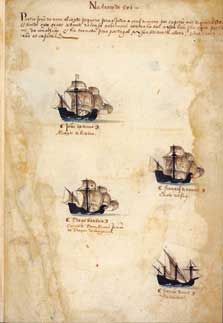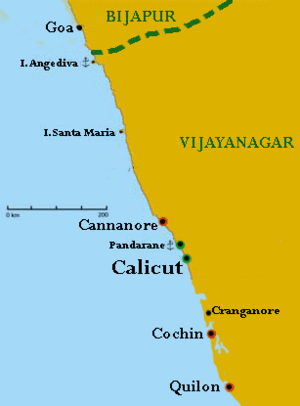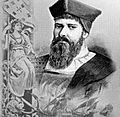3rd Portuguese India Armada (Nova, 1501) facts for kids
The Third Portuguese India Armada was a small fleet of ships sent by King Manuel I of Portugal in 1501. It was led by João da Nova. This fleet was mainly for trading, but it also took part in the first important sea battle for Portugal in the Indian Ocean. On its journey, the Third Armada discovered two islands in the South Atlantic Ocean: Ascension and Saint Helena. Some people think this fleet was also the first Portuguese group to reach Ceylon, which is now called Sri Lanka.
Contents
The Ships and Crew
Not much is known about the Third Armada of 1501 compared to other early Portuguese India armadas. The old records don't have many details and sometimes disagree.
This Third Armada was mostly a trading trip to India. It had four ships: two belonged to the king, and two were owned by private companies. There might have been a fifth ship that carried supplies.
| Ship Name | Captain | Notes |
| Not sure | João da Nova | Main ship, owned by the king |
| Not sure | Francisco de Novais | Owned by the king |
| Not sure | Diogo Barbosa | Owned by a private noble, D. Álvaro of Braganza |
| Not sure | Fernão Vinet | Owned by a private company from Florence |
| Supply ship? | Unknown | Not certain if it existed. If so, it was likely left behind or burned. |
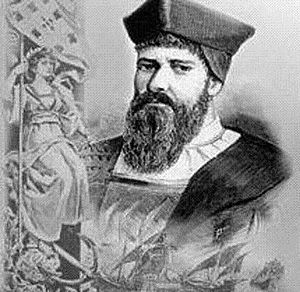
The fleet had about 350 to 400 men, but only about 80 of them were soldiers. The admiral, João da Nova, was a nobleman from Galicia. He was chosen because he had connections to a powerful Portuguese noble named Tristão da Cunha.
The private companies that owned two of the ships had also helped pay for a ship in the Second India Armada (led by Pedro Álvares Cabral), which was still at sea. It was a big risk for them to send new ships before knowing if the first trip was successful. Luckily, the ship from the Second Armada returned safely later in 1501 with many spices.
Some people thought da Nova's ships were sent to help Cabral because of a war with the Calicut kingdom. However, the Portuguese king didn't know about the war until Cabral's ships returned, which was six months after da Nova had already left Lisbon.
The Mission
The main goal of the Third Armada was to trade. Its job was to sail to India, load up with spices, and come back home. They expected the trip to be easy.
Their destination was Calicut (now Kozhikode), a major spice trading center in India. The Third Armada hoped that the Second India Armada had made a peace treaty with Calicut and set up a trading post there. However, they didn't know that Cabral's fleet had failed and had actually started a war between Portugal and Calicut. So, João da Nova's Third Armada was sailing into a war they didn't expect and weren't ready for.
The Third Armada also planned to stop at Sofala in Africa, where Cabral was supposed to set up another trading post. But Cabral's fleet had also failed that mission.
The fleet couldn't wait for news from the Second Armada. The strong seasonal winds in the Indian Ocean (monsoons) meant that ships going to India had to leave Lisbon by April at the latest. If they waited, they would miss the good winds and lose a whole year. So, the king and the private companies sent the Third Armada in March 1501, even without knowing what happened to the Second Armada.
Nova's Third Armada would learn about the Second Armada's problems from notes and letters left at stops along the African coast. Even if they learned about the war, they couldn't go back for more help. They had to keep going, try to get into India quietly, avoid Calicut, load spices at friendly ports, and leave as fast as possible.
Journey to India
The Third Portuguese Armada left Lisbon for India sometime in March or April 1501.
On their way, the ships discovered Ascension Island. They named it Conception Island at first, but later it was called Ascension. This name likely came from Ascension Day, a Christian holiday, which was on May 20, 1501.
The fleet sailed around the Cape of Good Hope on July 7, 1501. At Mossel Bay in South Africa, Nova found a note left in a shoe by Pêro de Ataíde, a captain from the returning Second Armada. The note warned that Calicut was now an enemy, but Cochin (now Kochi) and Cannanore (now Kannur) were still friendly places to get spices. It also suggested going to Malindi for more detailed letters from Pedro Álvares Cabral.
It's thought that João da Nova also built a small chapel at Mossel Bay during his visit. Later, he may have discovered Juan de Nova Island and the Farquhar atoll in the Mozambique Channel.
In mid-July 1501, the Third Armada arrived at Mozambique Island. Nova decided not to send one of his ships to Sofala, probably because he felt he needed all his men for possible fighting in India.
The armada then reached Kilwa, a Swahili city. A Portuguese exile, António Fernandes, met them and told Nova about the situation in Kilwa. Nova was careful and didn't go ashore, but he got some supplies, like citrus fruit, for his crew who were sick with scurvy.
Some reports say Nova sailed straight to India from Kilwa. Others say he went to Malindi first to deliver a letter to the Sultan. In Malindi, he supposedly received Cabral's letters, which gave him more details about the war with Calicut and the friendly ports of Cochin and Cannanore.
Nova in India
In August 1501, João da Nova's Third Armada reached the Santa Maria islands off the Malabar coast of India. Nova named them after the Feast of the Assumption of Mary (August 15).
After arriving, the fleet sailed down the Indian coast. They tried to capture two merchant ships near Mount d'Eli.
The Third Armada arrived in Cannanore in November. The local ruler, the Kolathiri Raja, welcomed them and offered to sell them spices. Nova said no because he needed to pick up supplies already bought by the Portuguese trading post in Cochin. Before leaving Cannanore, Nova left some agents to buy spices like ginger and cinnamon for later loading.
While in Cannanore, João da Nova received a message from the ruler of Calicut, the Zamorin. A Portuguese survivor from a massacre the year before, Gonçalo Peixoto, was with the message. The Zamorin said he was sad about the Calicut Massacre and blamed it on hatred between Muslims and Christians. He claimed he wanted peace with Portugal and invited Nova to Calicut to get back goods left behind and receive payment. The Raja of Cannanore told Nova to accept the offer. But Gonçalo Peixoto warned Nova that the Zamorin was setting a trap and preparing a war fleet. Nova did not reply to the Zamorin. Peixoto joined Nova's fleet.
Some accounts say Nova did go to Calicut. He waited for goods, but a Christian warned him of the Zamorin's bad intentions. Before leaving, Nova captured three merchant ships, including one owned by the Zamorin, and burned them in front of the city. They took valuable items like silver and navigation maps from the ships.
When Nova reached Cochin, he met Gonçalo Gil Barbosa, a Portuguese trader left by Cabral. Barbosa said it was hard to trade because Indian merchants wanted silver, but he only had Portuguese goods like cloth. These goods weren't worth much in India, so he couldn't get silver to buy spices. He thought Arab merchants were stopping people from buying Portuguese goods. The ruler of Cochin was also angry because Cabral's fleet had left too quickly.
Nova didn't have much silver, which was a big problem. He expected to get cash by selling Portuguese goods.
Nova immediately sailed back to Cannanore to see if his agents there had found any silver. They had the same problem. The Kolathiri Raja of Cannanore finally helped. He promised to make sure the Portuguese could buy spices on credit.
Discovery of Ceylon
In 1898, a stone with a Portuguese writing and the date 1501 was found in Colombo, Sri Lanka. This was four years before Lourenço de Almeida officially discovered Ceylon (Sri Lanka) for Portugal in 1505.
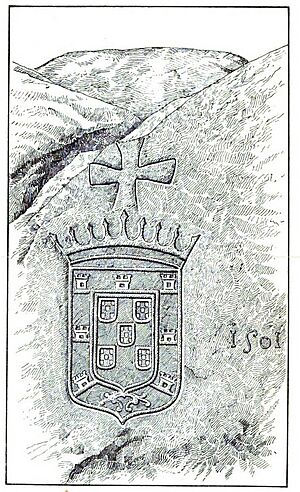
Many people have wondered about this stone. Some think it was a marker of a Portuguese claim, like a flag. Some historians believe the inscription was made by a captain from the Third Armada in 1501. The records of the Third Armada's journey don't mention them finding Ceylon, but the journey was not well recorded overall.
One idea is that the discovery happened during an exploration trip from nearby islands. Another idea is that the journey to Ceylon happened in late November or early December 1501. In this case, Nova or one of his captains might have found Ceylon by accident or with local help, hoping to find better trading there.
None of these ideas are fully confirmed in old written records.
First Battle of Cannanore
In mid-December 1501, the Third Armada was getting ready to leave India with spices from Cannanore and goods from their attacks on other ships. But then, news arrived that the Zamorin's war fleet was coming.
Nova's fleet was trapped by the Zamorin's fleet near Cannanore. The Zamorin had about 40 large ships and 180 smaller boats, with an estimated 7,000 men.
The Raja of Cannanore told Nova to stay safe under his protection. But Nova decided to try and break through the enemy ships. The Third Armada fired its cannons to create a gap in the Zamorin's line. Once a gap opened, the four Portuguese ships charged through in a line, firing their cannons from the sides.
The powerful cannons and the height of Nova's ships stopped the Calicut forces from climbing aboard. The Zamorin's fleet, which was not as strong in the open sea, started to break apart from the intense cannon fire. As the distance grew, the battle became a fight with cannons from afar. The Calicut fleet retreated because their cannons couldn't shoot as far or reload as fast as the Portuguese ones. Nova chased them for a short time and then ended the fight on January 2, 1502.
After two days of fighting, the Third Armada had sunk five large ships and about a dozen smaller boats. They caused a lot of damage to the Zamorin's remaining ships, while their own ships were not badly hurt.
Even though João da Nova wasn't ready for a fight, this two-day naval battle off Cannanore is seen as the first important sea battle for Portugal in the Indian Ocean. Earlier fights were usually against poorly armed merchant ships or pirates. In this battle, the Zamorin of Calicut attacked directly with his best fleet against a small group of Portuguese trading ships, which were not as heavily armed as other Portuguese war fleets.
This battle is also important because it was one of the first times ships deliberately used a "naval column" formation, later called a "line of battle," and won a fight using only cannon fire. These tactics became very common as naval technology improved, making this battle sometimes called the first modern naval battle.
Return Journey
In early 1502, the Third Armada captured another Calicut merchant ship near Mount d'Eli, took its goods, and burned it. Soon after, they began their journey home. They stopped twice in East Africa for water: first at Malindi, and then at Mozambique Island.
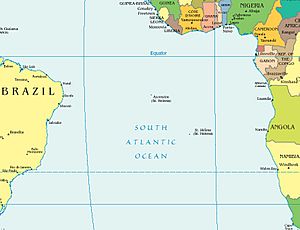
After sailing around the Cape of Good Hope, Nova entered the South Atlantic Ocean. On his way back, he discovered the uninhabited island of Saint Helena. It's believed the island was named after Saint Helena, possibly on her feast day, May 21. According to stories, Nova anchored on the west side of the island and built a small wooden chapel. Saint Helena became a regular stop for future Portuguese trips to India. Its location was kept a secret by the Portuguese for about eighty years until an English captain found it in 1588.
Nova's Third Armada arrived back in Lisbon on September 11, 1502. They brought back a good amount of black pepper, cinnamon, ginger, and other goods. The amount of cinnamon led some to believe the fleet visited Ceylon, but cinnamon was also available in other Indian markets. Some of the cinnamon might have come from the captured ships.
What Happened Next
The Third Armada's trip was not seen as a huge success. Even though they didn't lose many ships or men, they came back with fewer spices than expected. Their ships were partly empty. Nova also failed to trade for gold in Africa. The news that it was hard to get cash in India and that the fleet had to rely on piracy to fill its ships disappointed Portuguese merchants. They had thought it would be easy to make money on these trips. However, the discovery of Ascension Island and Saint Helena was good news. The armada returned too late to share information with Vasco da Gama's heavily armed 4th India Armada, which had already left Lisbon.
Images for kids
-
João da Nova, the leader of the Third Armada.
-
A Portuguese inscription found in Colombo, Sri Lanka, dated 1501. Some believe it was left by the Third Armada.
-
Positions of Ascension island (discovered by the Third Armada in May 1501) and Saint Helena (discovered May 1502) in the South Atlantic Ocean.
| Preceded by 2nd Armada (Pedro Álvares Cabral, 1500) |
Portuguese India Armada 3rd Armada (1501) |
Succeeded by 4th Armada (Vasco da Gama, 1502) |


